Frisco
Science Outpacing EPA Lead Contamination Standards
 People who don't know any better expect agencies that are charged with removing environmental threats to public health to be on top of the best and most recent science. However, because of the glacial pace of government environmental oversight, that's hardly ever true. It takes years, and sometimes decades for "safe standards" to be updated or created. When they are, they're sometimes instantly obsolete because a new generation of studies has shown harm at even lower levels of exposure. This is why impacted citizens have to have a DIY philosophy to seek out the most recent science themselves – you can't depend on government to have already incorporated it or be using it as a guide.
People who don't know any better expect agencies that are charged with removing environmental threats to public health to be on top of the best and most recent science. However, because of the glacial pace of government environmental oversight, that's hardly ever true. It takes years, and sometimes decades for "safe standards" to be updated or created. When they are, they're sometimes instantly obsolete because a new generation of studies has shown harm at even lower levels of exposure. This is why impacted citizens have to have a DIY philosophy to seek out the most recent science themselves – you can't depend on government to have already incorporated it or be using it as a guide.
A particularly depressing example is the way the US EPA is dealing with lead contamination and its soil and dust standards. The last time these were updated, Bill Clinton was President. There's been a lot of science produced on lead poisoning since then and all of it points to lower and lower levels of exposure causing harm. In fact, there's a consensus among researchers that there is NO safe level of exposure to lead. It's not that every exposure will harm you, it's that every exposure is capable of doing harm – especially to children.
There's also overwhelming public policy consensus that exposures to lead should be minimized as much as possible. Reducing exposure to lead is now linked, not just to better physical health, i.e. less cancer, liver disease, etc., but to higher IQs and test scores in schools, less anti-social behavior, and even less crime. In California, the lead standard for soil has been reduced to 80 parts per million, compared to the circa-2000 EPA standard still in place of 400 ppm.
Acting in recognition of these facts, for the first time in over 20 years the federal Centers for Disease Control revised its lead-in-blood standard for children in 2012, cutting in half the amount it said should trigger a response from parent and doctor. As a consequence, the EPA's own Children's Health Protection Advisory Committee sent a letter to then-Administrator Lisa Jackson calling for the agency's "immediate and urgent attention" to revise the nation's lead dust and soil standards because they had been based on the previous, now-obsolete CDC standard.
But in the latest installment of her year long award-winning series of articles on the topic, USA TODAY's Allison Young quotes EPA officials as saying they have no current plans to update those standards to reflect the new CDC lead in blood action level. This, despite studying the issue since 2009. What difference does it make?
In places like Frisco, Texas that experienced decades of lead contamination from a poorly and often illegally-operated lead smelter, it means the EPA will allow what it knows to be dangerous levels of lead to remain in soil and dust that otherwise would have to be cleaned-up.
This is Exhibit A why citizens cannot leave environmental protection to government agencies alone. This is why Frisco residents, organized by Frisco Unleaded, are trying to intervene directly in the closure and clean-up of the Exide lead smelter. If you leave it up to the state or EPA, you won't have the best science, or the most protective clean-up. You will have settled for whatever government standard was in place at the time, no matter how outdated or unsafe. If you're a parent in Frisco, that shouldn't be YOUR standard.
Former Exide Smelter Employee: It WAS as Crappy As You Thought
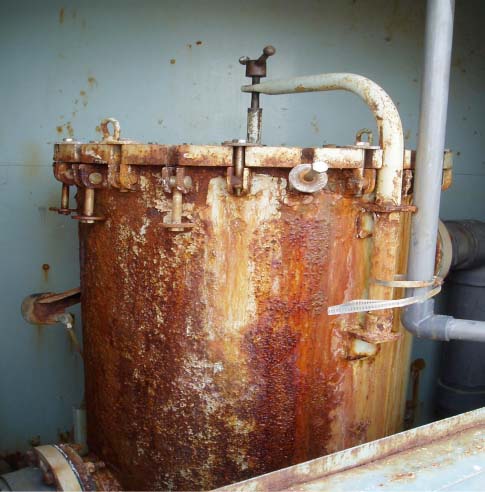 Although the Great Dallas Drilling Scandal has kept our heads spinning lately, we did mange to take note of a rather big story in a small paper that should get a lot more coverage.
Although the Great Dallas Drilling Scandal has kept our heads spinning lately, we did mange to take note of a rather big story in a small paper that should get a lot more coverage.
On February 21st, the Frisco Enterprise-Plano Star community newspaper published an article about the Exide lead smelter in Frisco using an unnamed ex-Exide employee as the sole source. The sole source's anonymity probably kept major outlets from offering the same coverage, but in this case the specifics are so compelling that we're glad the suburban chain took the chance.
Although he never gives his name, the Star says the employee "served in a managerial position at the plant." From the workday scenarios he describes he appears to have been directly involved in Exide's production line. Taken together, all of the accounts he gives the paper would seem to confirm residents' impression that the circa- mid 1960's Frisco facility was a mobile home park with a lead smelter in the middle of it.
"I guess we were probably producing $200,000 worth of product every shift — $600,000 worth of product every day," he said. "Yet [one time] we had six people working on [maintenance when the plant lost power]. We had one flashlight and one set of tools. What I needed was six flashlights and six sets of tools, but they wouldn't even give me that."
If Exide wouldn't open up the corporate wallet for flashlights, no wonder the company balked for so long about adding multi-million pollution controls to reduce lead emissions to legal levels.
And, according to the Star's source, those lead (and cadmium and arsenic) emissions could be many times what's been officially estimated by government agencies, or even citizens' own air modeling results published last year.
Power being knocked out was a particular issue, the source said, as vapors resulting from the lead-acid recycling system were no longer captured. Those vapors include lead particles, and long periods of lead exposure result in chronic lead poisoning, which in turn can result in physical defects such as kidney damage.
The former employee doesn't say how often this kind of outage occurred, but he makes it clear it wasn't infrequent. It wouldn't take too many such incidents to significantly raise the exposure level of those residents living downwind. Of course, when the state and EPA are calculating what constitutes "safe" levels of exposure to a facility's pollution, they never take into account these kind of "upsets" or accidents that can balloon the chances of inhaling harmful poisons.
Among the other allegations made by the ex-employee:
Only 1/5 of the violations Exide received "for a lack of federal compliance or unsafe working conditions" were forwarded to the Texas Commission on Environmental Quality.
Incident reports submitted to the state about violations represented "a great difference in the truth" between what was being claimed by Exide, and what really happened.
These incidents were as frequent as every other week.
Prior to the announced visits of TCEQ or EPA inspectors, "employees were paid overtime to clean the plant extensively. The same initiative was made before visits by non-plant employees, such as trips by corporate managers. Outside of those events, however, the plant was rarely cleaned."
Carbon dioxide monitors were constantly beeping, indicating dangerous CO2 levels. "The environment of operations was poisoning us."
Ah, but all of that is in the past, right? Not with Exide planning to leave over 9 million pounds of lead smelter waste behind on 90 acres in the middle of central Frisco, with another hundred acres or so outside of that donut hole" being purchased by the city for rehabilitation.
When asked if he would feel comfortable visiting the land Frisco purchased from Exide when it's remediated to federally compliant levels, the former employee said he wouldn't.
"With the way it's going right now, I'll never take my children or my dog to that area," he said. "I studied petroleum engineering and geology in college, and I know the bad stuff sinks to the bottom. I will never [go there]. It'll be nice to have it gone, but I don't know how you patch that up. You have to pull up everything, wrap it up and get it gone."
Official reaction was predictable:
"An Exide Technologies spokeswoman said the company "does not comment on unsubstantiated hearsay"…"A TCEQ spokeswoman said she could not comment on whether or not an employee signing an incident report with false information would be illegal without being told what reports are in question."
It'd be better if former employees like this came completely forward and were willing to cooperate with the EPA in exchange for immunity, but we're grateful for the peak inside Exide. It confirms not only what we already suspected about the way this company and this plant did business, it also once again confirms the way all bad acting polluters behave when it comes to hiding their real identity from the public and regulators.
Shorter DMN: Citizens Demanding Frisco Smelter Clean-Up Hate Mexican Children
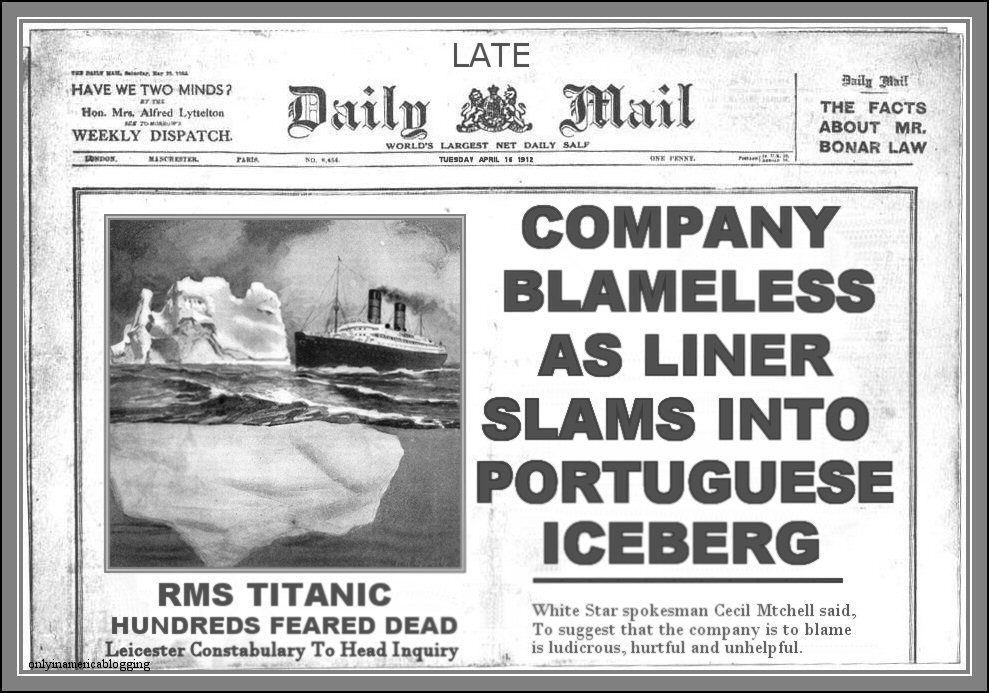 Because closing illegal smelters in your own backyard forces the corporations to build unsafe facilities in other places….or something like that.
Because closing illegal smelters in your own backyard forces the corporations to build unsafe facilities in other places….or something like that.
EPA Challenges State Clean-Up of Frisco Smelter Waste
 Despite denying that it was submitting comments on the state's plan for cleaning up the recently closed Exide lead smelter, the Environmental Protection Agency turned in a sometimes scathing assessment of Austin's proposal to allow the company to treat prohibited hazardous waste that still lies buried in its landfills in Frisco.
Despite denying that it was submitting comments on the state's plan for cleaning up the recently closed Exide lead smelter, the Environmental Protection Agency turned in a sometimes scathing assessment of Austin's proposal to allow the company to treat prohibited hazardous waste that still lies buried in its landfills in Frisco.
"The landfill is not permitted or constructed as a hazardous waste unit. Please clarify the regulatory/statutory provisions TCEQ is following that would allow for treatment of hazardous waste in the landfill," wrote EPA Associate Director Susan Spalding in a five-page letter sent to the Texas Com mission on Environmental Quality (TCEQ) on January 25th.
News of the Agency's comments comes on the eve of a public meeting scheduled by Exide for Wednesday night at the historic Frisco Depot to explain its clean-up operation.
Besides criticizing the on-site treatment of the hazardous waste, EPA also had a harsh review of the way Exide and TCEQ had identified areas of the current landfill with concentrated lead wastes that needed treatment, suggesting four times as much sampling as the company had proposed, and TCEQ had approved.
EPA also noted that a closed landfill in Frisco was already leaking hazardous levels of lead and selenium and suggested that the treatment method Exide is using in its current landfill was not going to be effective.
But in what may be a crushing blow to the company's plans to keep the wastes it generated for almost five decades buried in Frisco permanently, EPA stated that if the current landfill had been used for disposal after 2011 sampling to determine clean-up, which it almost certainly has,"This may require removal of all material" in the landfill.
Many of the problems cited by the Agency are the same ones citizens have been complaining about since Exide announced its unusual scheme to try to treat its illegal hazardous waste in place in its Frisco landfill, instead of digging it up and re-burying it in an official, licensed hazardous waste disposal site.
Exide does not have a permit to handle or dispose of hazardous waste. It's landfill is classified as a "non-hazardous waste" disposal site. The hazardous waste inside of it was discovered by inspectors several years ago.
Citizen groups have said Exide must apply for a full Resource Conservation and Recovery Act permit in order to deal with its prohibited wastes. EPA's letter seems to suggest that the Agency agrees.
Besides commenting on the landfill plans, EPA's letter also seeks changes in the dust controls guiding the smelter clean-up, and the public release of information about the clean-up.
Copies of the EPA letter can be downloaded from the Frisco Unleaded website here.
"We're very appreciative that EPA changed its mind and decided to comment on the ridiculous plans by Exide and TCEQ to use the same treatment method on this hazardous waste that failed to work the first time," said Colette McCadden, Chair of Frisco Unleaded, the citizens group who successfully campaigned to close the old smelter last year.
"We hope the EPA continues to provide needed oversight to what Exide and the state are doing – or not doing."
Other groups were more cautious.
"It's a pleasant surprise to see EPA comment so bluntly about the more absurd parts of the proposed Exide clean-up," said Jim Schermbeck of Downwinders at Risk. "My hope is that this is only the beginning of a new level of review for Exide by the Agency in light of the USA Today's "Ghost Factory" series chronicling what happens when it's not paying such attention. Only time will tell."
They’re Not Asking Your Permission
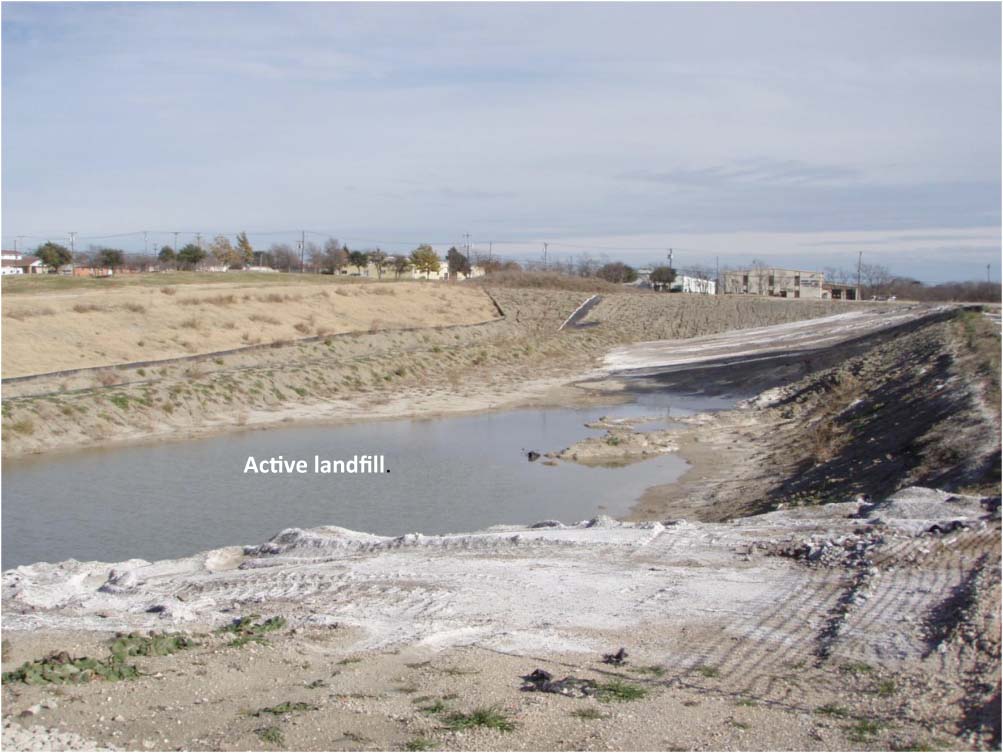 Exide and the State are planning Frisco's future without it's residents.
Exide and the State are planning Frisco's future without it's residents.
This Wednesday night may be one of the few times they can object in person.
Plans are proceeding for Exide to leave landfills full of its lead smelter waste in Frisco….forever
Landfills of lead on the edge of downtown that will pose a constant public health threat and economic dead zone
Landfills of lead along the banks of Stewart Creek as it flows downstream into the City's new "Grand Park"
Join us in saying no to their lead-filled future of Frisco.
Exide's Public Meeting on their lead smelter "Clean-up"
THIS WEDNESDAY NIGHT
7:00 pm
Frisco Depot
6499 Paige Street
(in the Historic District by Babe's)
Whether Frisco residents like it or not, Exide and the State of Texas are deciding to let millions of pounds of lead waste stay buried in Frisco forever – and the current City Council isn't trying to stop them.
While the city bought the less-contaminated outer ring of the Exide lead smelter, the most toxic part of the facility is still owned by Exide.
The City of Frisco has said that it won't interfere in the way the company and state decide to handle the tons of lead waste buried in this area, which stretches from Stewart Creek to the edge of downtown.
Exide, the state, and this city council are all deciding that it's easier just to leave lead contamination permanently buried in place in the middle of Frisco instead of moving it away from people and flowing water.
If citizens don't show up and fight back against these plans, Frisco residents will be dealing with lead contamination issues for decades – just like other communities that didn't have their lead smelter waste cleaned-up completely either.
A former Exide smelter site still sits abandoned in Dallas, some two decades after it closed, surrounded by monitoring wells and a chain link fence. We can't let that happen here.
Many residents sent e-mails to Exide last week saying they wanted a complete clean-up of its lead waste in Frisco. Now they need to come in person with the same message.
Frisco residents have to stand up for their home and community. Nobody at Exide or in government is.
Was Lead Contamination the Major Cause of 20th Century American Crime?
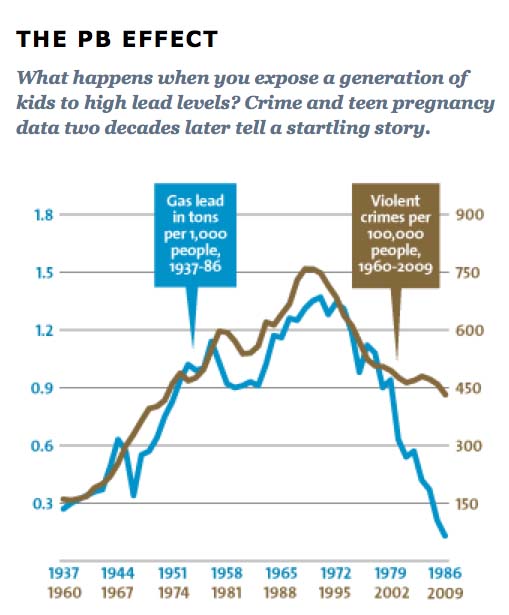 That's the hypothesis that Kevin Drum makes in the latest issue of Mother Jones, and he has a lot of evidence to back it up.
That's the hypothesis that Kevin Drum makes in the latest issue of Mother Jones, and he has a lot of evidence to back it up.
For years, scientists have known about the link between lead exposure in children and decreasing IQ levels. More recently, researchers have discovered more subtle effects in terms of anti-social behavior and AHHD diagnosis. Now, modern toxicology is to the point where most leading researchers say there is no level of lead a child can be exposed to that doesn't have the potential to effect his or her personality.
What if you were to use what we know now about the effects of lead contamination on young minds and playback the last 70 years of American history?
The biggest source of lead in the postwar era, it turns out, wasn't paint. It was leaded gasoline. And if you chart the rise and fall of atmospheric lead caused by the rise and fall of leaded gasoline consumption, you get a pretty simple upside-down U: Lead emissions from tailpipes rose steadily from the early '40s through the early '70s, nearly quadrupling over that period. Then, as unleaded gasoline began to replace leaded gasoline, emissions plummeted.
Gasoline lead may explain as much as 90 percent of the rise and fall of violent crime over the past half century.Intriguingly, violent crime rates followed the same upside-down U pattern. The only thing different was the time period: Crime rates rose dramatically in the '60s through the '80s, and then began dropping steadily starting in the early '90s. The two curves looked eerily identical, but were offset by about 20 years.
So Nevin dove in further, digging up detailed data on lead emissions and crime rates to see if the similarity of the curves was as good as it seemed. It turned out to be even better: In a 2000 paper (PDF) he concluded that if you add a lag time of 23 years, lead emissions from automobiles explain 90 percent of the variation in violent crime in America. Toddlers who ingested high levels of lead in the '40s and '50s really were more likely to become violent criminals in the '60s, '70s, and '80s.
Dr. Howard Mielke of Tulane, who's analyzed the blood lead data collected from Frisco and found the samples higher than the state average, makes an appearance in Drum's article because of a large new study overlaying neighborhood lead exposure to neighborhood crime in six American cities. They match up precisely.
Read the short version of the article here. Here's an interview with Dr. Mielke.
No one knew a lead additive in gasoline would produce such an impact. Because we didn't do the toxicology. Lead was introduced in gasoline in the 1920's when the modern industrial age was just hitting its stride. Now there are some 80,000 chemicals in the marketplace, only a handful of which have been tested thoroughly, including lead, because we're still not doing the toxicology BEFORE the chemical is used in widespread commerce.
Cancer. Birth Defects. Endocrine Disruptors. Why is it so inconceivable to some that the thousands of untested chemicals coursing through the veins of our economy can't have unintended consequences just like leaded gasoline, on their own or in combination with each other? What new epidemics are we instigating even now?
Public Health Action Alert – Exide’s “Community Meeting” on Wednesday
 Please come and insist that the clean-up of the Exide lead smelter be open to public notice and comment, and not done behind closed doors.
Please come and insist that the clean-up of the Exide lead smelter be open to public notice and comment, and not done behind closed doors.
Exide is hosting a hastily called "public meeting" on demolition and dust control plans for its former Frisco lead smelter Wednesday night beginning at 7 pm at the Frisco Depot in the Historical District, 6499 Paige Street.
Among other things, Exide wants to permanently leave a waste landfill in central Frisco with approximately nine million pounds of smelter waste inside, instead of trucking it out.
The city is letting the company have its way, even though this landfill in downtown will be an impediment to economic development and a constant threat to groundwater and air contamination that will demand never-ending monitoring.
All of the decisions about the clean-up of the smelter site are taking place behind closed doors with no public input or notice.
Last Friday the company submitted its plan for the permanent hazardous waste landfill and got it approved the very same day without any public notice or comment.
Wednesday's meeting is about a demolition plan that has already been written by the company without listening to any public concerns. They're only letting residents know about it after the fact.
We know it's the holiday season – that's why Exide scheduled this meeting. The company hopes you've quit paying attention. We hope you haven't.
There's a lot of dangerous material on the Exide site. If it's not disposed of correctly, Frisco could have an economic and public health black hole in the middle of town forever, what USA Today called lead "ghost factories." That's why this is important.
Meanwhile, the city of Frisco is protecting your interests by…being a silent partner to Exide's plans. City Hall has defaulted to the state and the company's judgment and isn't acting as an independent watchdog.
The City is writing press releases with Exide, but it isn't asking hard questions about the clean-up, or hiring its own experts to double-check what Exide and the state are proposing. It isn't demanding public notice or comment on behalf of residents. In fact, the city is keeping information about the clean-up and smelter to itself, refusing to post it online or release it to residents or reporters.
Come to the Wednesday night Exide meeting to express your displeasure with a strategy that's putting the same people responsible for creating the Exide mess in charge of "cleaning it up."
At this point we need the same public pressure that caused the city to change course and close the outlaw smelter to help open the closed doors that are hiding the clean-up process from public view.
Good Friday: Exide Smelter Closing Today
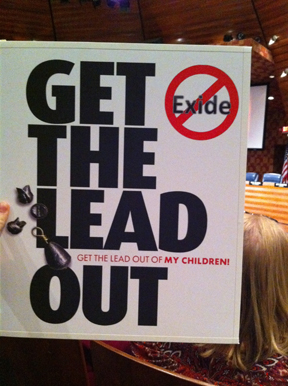 Sometimes, all it takes is the slightest push of an index finger, or a focused exhaling of breath.
Sometimes, all it takes is the slightest push of an index finger, or a focused exhaling of breath.
Sometimes the house of cards is so precarious, so unstable, that any challenge, no matter how slight, can send the established structure to the ground.
A year ago a small, newly-formed citizens group that had just staged its first action was struggling to convince the City of Frisco to quit supporting co-existence with an outlaw lead smelter and instead kick it out of town.
Today, that smelter will stop operating.
Community activism rarely pays off as quickly or as spectacularly as it has with the curious case of the Exide lead smelter. But when it does, it's reason to pause and give thanks and remind ourselves that such things are still possible.
Because truth be told, this historic effort was directed by a group of Frisco residents that was never larger than 10 people strong. Please just think about that. Less than a dozen people challenging their local status quo are responsible for this huge victory for public health.
Downwinders' often tells its supporters that, like the Woody Allen quote about life, 90% of social change is about just showing up. The system so often goes completely unchallenged, that you'd often be surprised what happens when you just show up and start asking embarrassing questions. When you start poking at the house of cards.
As their campaign proceeded, this small group of committed people attracted the support of hundreds, and then thousands of their fellow residents. They forced the city to see the contradiction between the continued operation of a circa-1960's smelter and the reality of 2012 Frisco. They held up a mirror and re-framed the relationship between smelter and town. And the contradiction was so great, so at odds with the new perception of Frisco, that the established political support the smelter had enjoyed in town for decades dried up. Young couples with kids concerned about a lead smelter they never heard of before outnumbered Good Ol Boys in City Hall and the Chamber of Commerce. The old establishment was undone by the very demographics of change they'd unleashed a decade or so earlier.
There is still much work to do. A half-century of contamination blankets the smelter site, as well as an undetermined number of off-site "hotspots." Exide wants to leave a permanent landfill behind in the middle of Central Frisco, while the City is breezing along with plans to turn a piece of land right across the street from the smelter site into the city's largest park. Downwinders will be helping citizens monitor the cleaning-up of the smelter site for at least the next two years.
But as of today there is no more lead pollution coming out of the Exide smokestacks. No more daily fallout of poison. No more new layers of lead being laid down in the topsoil of Frisco. That is a pretty remarkable thing considering where we were 365 days ago.
So raise your glasses tonight to the hardy folks of Frisco Unleaded and the improbability of the impossible happening in record time. Here's to Colette McCadden, Henrik Ax, Shiby Matthew, Matt Vonderahe, Jeannette Sandin, Meghan Green, and Eileen Canavan, all residents who decided they would stick their neck out and start showing up and asking questions, much to the consternation of the Powers That Be. May they all have Frisco parks, and schools, and streets named after them.
It's not always this easy, but the fact that it was this time should give us hope about the power of pushing back.
Even Low-Level Cadmium Exposure in Womb Can Lead to Lower IQ
 By way of the Environmental Health News comes word of a new study looking at the effects on low-level, "ambient" levels of the toxic metal Cadmium on 5 year-olds in Bangladesh.
By way of the Environmental Health News comes word of a new study looking at the effects on low-level, "ambient" levels of the toxic metal Cadmium on 5 year-olds in Bangladesh.
Although the exposure pathway in the study assumes the Cadmium is coming primarily from a diet of food grown in contaminated soil, the results speak to the possible effects of any kind of risk – inhalation or ingestion.
"Prenatal exposures to the metal cadmium — even at low levels common in most countries — can have long-lasting effects on children's IQ. A study from Bangladesh found that 5-year-olds who were exposed through their mothers to higher levels had IQs that were 2 to 3 points lower than less-exposed children. The new evidence suggests that even low-level exposures before birth may have continued effects on children's brain function.On average, scores dropped by 2 to 3 points in children with the highest exposures when compared to those with the lowest exposures. Even small drops in IQ may affect a child’s ability to succeed at school and work later in life. Lower IQ's across the population also have large impacts on society."
Cadmium is a naturally-occurring metal contaminant found at low levels in the environment. Industry uses it to make batteries, coat and plate plastics and other metals, and make paint (remember Cadmium Red?). It's also emitted by car exhaust, the burning of industrial wastes, coal, and oil. When spread on fields, fertilizers and sewage sludge contaminated with cadmium can increase levels in cropland soils.
What are some possible local sources of cadmium in the air? The Midlothian cement plants that are now increasingly burning industrial wastes. Steel mills – like the Ameristeel one in Midlothian. Lead smelters like the one Exide is closing up at the end of the month in Frisco, along with the slag and battery chips the smelter "landfarmed" in Frisco for decades. These are all in addition to the Cadmium you may be ingesting through your diet or by sucking on that cute charm bracelet you bought that was made in China.
Lead Exposure Linked to Gout
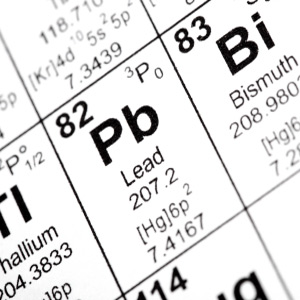 Since Downwinders was asked to help Frisco residents relocate a 50-year old lead smelter last year, there's been one study after another linking lead exposure to a variety of new health effects. This month it's gout.
Since Downwinders was asked to help Frisco residents relocate a 50-year old lead smelter last year, there's been one study after another linking lead exposure to a variety of new health effects. This month it's gout.
"Even relatively low levels of lead in the blood may be linked to an increased risk of gout, a painful form of arthritis, researchers reported Monday.
"All of this suggests there's no such thing as 'safe' or 'acceptable' lead levels," said study leader Dr. Eswar Krishnan, of Stanford University School of Medicine in Palo Alto, California.
No one is going to be doing a health survey in Frisco anytime soon looking for increased rates of gout, or liver damage, or cancer, or lower IQ levels. Once a facility like the Exide lead smelter puts poisons into the air, they cannot be recalled, nor the damage they create. Because we don't know all the damage their poisons can create. But that doesn't keep companies or governments from approving the release of them into the air. Years later, studies are done and we all learn about a new kind of damage they can leave. But the damage cannot be removed, or mitigaged or even compensated, because there's no direct connection to Exide left to identify.
And that's why we must make sure we know what's being released into the air for us and our families to breathe before we're exposed to it.
